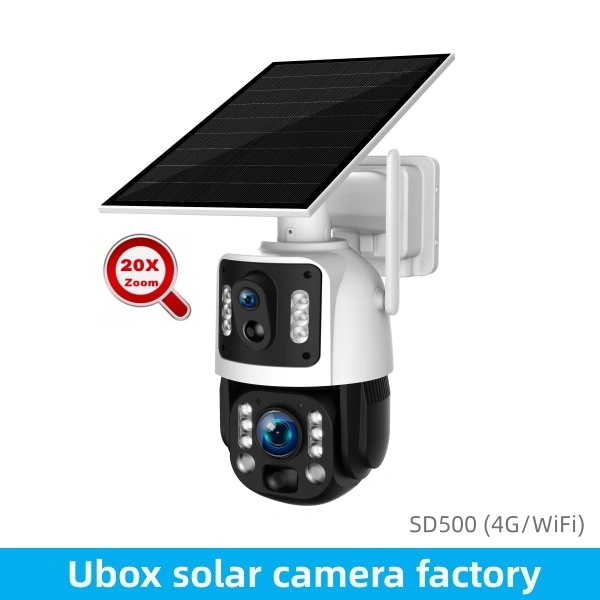Solar Security Camera Storage: Local SD Card vs. Cloud—An Engineer’s Deep Dive
As a B2B partner, your reputation hinges on the reliability of the security solutions you sell or install. You’ve sourced the best solar-powered security cameras, but a critical question remains: where should the footage be stored? This single decision impacts cost, accessibility, and security more than any other factor. Get it wrong, and your client could face data loss during a critical incident, crippling operational costs, or a system that fails when it’s needed most.
The debate between local SD card storage and cloud storage isn’t just about features; it’s about matching the technology to the business application. With over 13 years designing and manufacturing these systems at UBOXCAM, I’ve seen firsthand how the right storage strategy can make or break a deployment, whether it’s for a remote construction site, a sprawling farm, or a new brand’s product line. Let’s move beyond the marketing hype and conduct a rigorous, engineering-level comparison.
Understanding this choice is fundamental. Storage is the “black box” of your security system. It’s the definitive record of events. We will break down the core mechanics of each option to help you build more robust, cost-effective, and reliable security solutions for your customers.
Core Comparison: On-Premise vs. Off-Premise Storage
At the factory level, we evaluate components based on performance, cost, and failure rates under stress. Applying this same discipline, let’s analyze local and cloud storage. The optimal choice is rarely one-size-fits-all; it depends entirely on the specific use case and your client’s priorities.
This table provides a head-to-head breakdown of the critical factors that should influence your decision as a brand, installer, or distributor.
| Feature | Local SD Card Storage | Cloud Storage |
|---|---|---|
| Cost Structure | One-time upfront cost per card. No recurring fees. Lower Total Cost of Ownership (TCO) for long-term, single-camera deployments. | Recurring monthly/annual subscription fee, often per camera. Can become expensive for large fleets of cameras. |
| Data Accessibility | Requires local network access or physical retrieval of the card. Some P2P apps allow remote viewing, but downloading large files is slow. | Accessible from any internet-connected device, anywhere in the world. Ideal for multi-site management and remote teams. |
| Bandwidth Dependency | Minimal. Recording is unaffected by internet connectivity. Perfect for 4G solar cameras in areas with weak or expensive data plans. | High. Requires a stable, consistent internet connection to upload footage. Network outages result in lost recordings. |
| Security & Privacy | High privacy; data never leaves the device unless remotely accessed. However, if the camera is stolen or damaged, the footage is lost. | Footage is safe from physical theft or damage. Security depends on the provider’s encryption and protocols. Potential for third-party data breaches. |
| Reliability & Lifespan | SD cards are physical media with a finite number of write cycles. Prone to failure in extreme temperatures. Use of industrial-grade cards is critical. | Managed by professionals in data centers with redundancy and backups. Extremely high uptime, but dependent on the service provider. |
| Scalability | Limited to the card’s capacity (e.g., 128GB, 256GB). Older footage is overwritten (FIFO). Expanding requires physical card replacement. | Virtually unlimited. Storage plans can be upgraded or downgraded on demand, accommodating changes in camera count or recording resolution. |
Application Case Study: Securing a Remote Construction Site
To see these trade-offs in action, let’s consider a common B2B scenario: a security installer is tasked with monitoring a large construction site for six months.
- Problem: The site has no existing Wi-Fi infrastructure and limited power. The primary needs are theft prevention of heavy machinery and liability monitoring. The project manager needs to access footage from their central office, but the data plan for a fleet of 4G solar cameras could be prohibitively expensive if streaming 24/7. Physical access to cameras is difficult and hazardous.
- Initial Flawed Solution: Deploying cameras that rely solely on cloud storage. This would lead to massive 4G data overage charges and a complete loss of recording capability during the frequent network congestion or outages common in developing areas.
- The UBOXCAM Hybrid Solution: We advised the installer to use our cameras that support both local and cloud storage. Each camera was fitted with a 256GB industrial-grade SD card for continuous, high-resolution local recording. The camera’s software was configured to only upload short, low-resolution motion-triggered event clips to the cloud via the 4G network.
- Result:
- 95% Reduction in Data Costs: By only uploading critical event clips, the monthly data usage per camera dropped from an estimated 200GB to under 10GB.
- 100% Footage Integrity: Even during network outages, the SD card captured a complete, uninterrupted record of all activity.
- Efficient Workflow: The project manager received instant motion alerts and could view the short clips remotely. If a full investigation was needed, they knew the exact time code to request for the high-resolution footage, which could then be downloaded remotely or retrieved physically at a later date.
This hybrid approach leverages the strengths of both systems, creating a resilient and cost-effective solution that meets the client’s business needs. Understanding how to implement this is what separates a standard installer from a true security solutions provider.
Troubleshooting & Engineering Insights (Q&A)
As an engineer, I focus on failure points. Here are common questions we receive from our B2B partners and the practical, no-nonsense answers.
Q: How long does an SD card actually last in an outdoor solar camera?
A: This is a critical point. A cheap, consumer-grade SD card can fail in less than six months due to the constant rewriting and extreme temperatures inside a camera housing. We strongly recommend and specify industrial-grade cards designed for high-endurance surveillance. These cards use wear-leveling technology and are rated for wider temperature ranges (-40°C to 85°C), typically lasting 3+ years under normal use. It’s a small upfront cost to prevent catastrophic data loss.
Q: What happens to cloud storage if my business stops paying the subscription?
A: Your access to all previously recorded footage will be cut off. Some services may delete your data immediately, while others offer a short grace period. This is a significant business risk. When choosing a cloud partner or offering a branded service, ensure the data retention and recovery policies are clear. For many end-users, losing access to historical data is a non-starter.
Q: If a camera with an SD card is stolen, is the data gone forever?
A: Yes, this is the single biggest weakness of a local-only storage model. If the physical device is compromised, the evidence is gone. This is why for high-security applications, such as monitoring cash-handling areas or sensitive access points, a hybrid approach with immediate cloud offload of event clips is the professional standard.
Future Trends: The Rise of Hybrid and Edge Intelligence
The market is clearly moving away from an “either/or” approach. The future of surveillance storage is hybrid. Sophisticated systems will use a large local SD card as the primary, high-resolution “truth file” while using the cloud for smart, efficient data management.
Furthermore, expect to see more intelligence at the edge. Cameras with advanced AI processors can analyze video directly on the device. Instead of uploading hours of empty footage, the camera can identify a person, a vehicle, or an animal, and upload only that specific, tagged event clip. This drastically reduces bandwidth and cloud storage costs, making 4G/5G cameras more viable for large-scale deployments. As a UBOXCAM partner, you are positioned at the forefront of this efficient and powerful trend.
Selection Guide: Which Storage Strategy for Your Business?
Use this checklist to advise your clients or define your product strategy:
- For 4G Operators & Rural Deployments: Prioritize local SD card storage to minimize data consumption. Offer cloud backup for critical events as a value-added service.
- For Brand Owners & Retailers: A seamless cloud service is key for a user-friendly consumer experience. Offer tiered plans (e.g., 7-day free event history, 30-day paid subscription) but always include SD card support for user choice.
- For Security Installers & Project-Based Work: The hybrid model is your best tool. It shows expertise and provides a robust solution that covers all eventualities, protecting both your client and your reputation.
- For Amazon Sellers & Entrepreneurs: Lead with flexibility. Market your product as having “Dual Storage Options” to appeal to both cost-conscious buyers (SD card) and convenience-focused users (cloud).
Key Takeaways for B2B Professionals
Choosing between local and cloud storage is a strategic engineering decision, not a simple preference. To build a successful business around solar security cameras, you must master these concepts:
- No Single Best Answer: The ideal solution depends on connectivity, security requirements, budget, and scale. Your value lies in guiding the customer to the right fit.
- Hybrid is the Professional’s Choice: For most serious commercial applications, combining the reliability of local storage with the accessibility of the cloud offers the best of all worlds.
- Quality Components Matter: Don’t let a $10 consumer SD card be the single point of failure in a $200 professional security camera installation. Insist on industrial-grade components.
- Focus on TCO (Total Cost of Ownership): Help your customers look beyond the upfront hardware cost. Factor in monthly data plans, cloud subscription fees, and the potential cost of lost footage when making a recommendation.
By understanding these nuances, you can deliver solutions that are not only technologically sound but also perfectly aligned with your customers’ business objectives. To discuss custom firmware that optimizes hybrid storage or to source reliable battery-powered security cameras with dual storage capabilities, reach out to our engineering team for a consultation tailored to your market needs.

